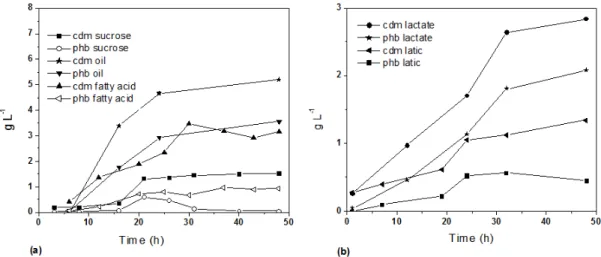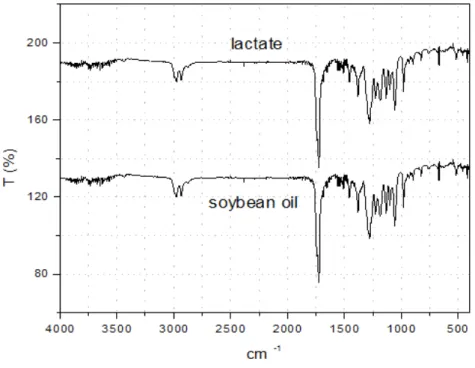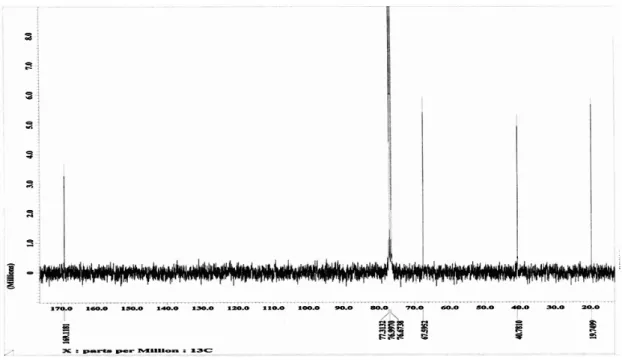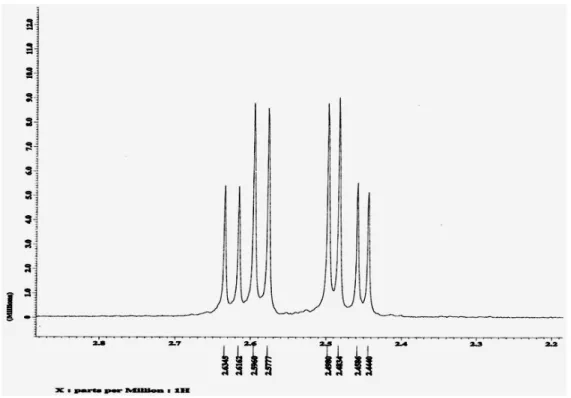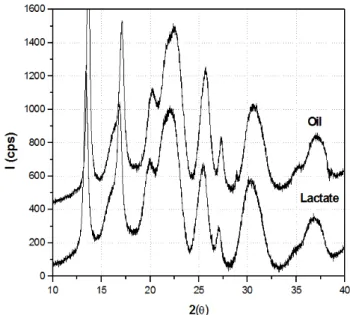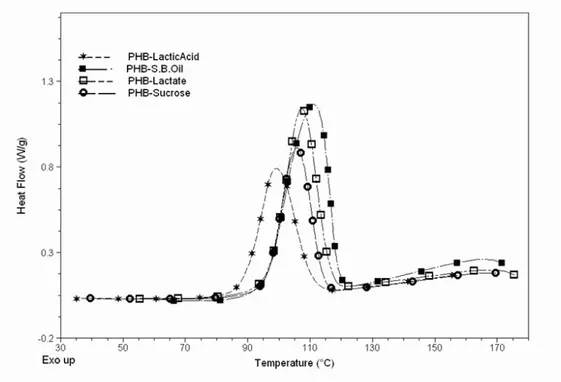http://www.materia.coppe.ufrj.br/sarra/artigos/artigo10881
Biosynthesis and characterization of biodegradable
Poly(3-hydroxybutyrate) from renewable sources
PEREIRA, S.M.F. I; RODRIGUEZ, R.S. I; GOMEZ, J.G.C. II I
Universidade Estadual do Norte Fluminense, CCT/ LAMAV-Campos dos Goytacazes, RJ, Brazil
e-mail: silvia@uenf.br,sanchez@uenf.br
II
Universidade de São Paulo – Departamento de Microbiologia/ICB, São Paulo, SP, Brazil e-mail: jgcgomez@usp.br
RESUMO
Poli(3-hidroxibutirato) (P3HB) foi produzido por cultura de Ralstonia eutropha DSM 428 e Alcaligenes latus ATCC 29712, em bioreator contendo meio mineral, a partir de diferentes substratos como sacarose, lactato sódio, ácido lático, óleo de soja e ácidos graxos como fontes de carbono. As bactérias foram capazes de converter os diferentes substratos em P3HB. Os melhores resultados foram obtidos com a cultura suprida com lactato ou óleo de soja. As massas molares numéricas médias (Mn) dos polímeros sintetizados, determinados por Cromatografia de Permeação em Gel, variaram de 1.65 x 105a 0.79 x 105 g mol-1. Os espectros no infravermelho mostraram absorbâncias características associadas com a estrutura do poliéster. O grau de cristalinidade, determinado a partir dos difractogramas de raios X, foi de 69 % para todos os polímeros sintetizados. As propriedades térmicas associadas a estes polímeros semicristalinos indicaram uma transição vítrea em 0.1ºC e um ponto de fusão em torno de 175ºC e entalpia de 63-89 J g-1. Os espectros de 1
H-NMR and 13C-RMN dos polímeros estão de acordo com os deslocamentos químicos associados com a estrutura do P3HB.
Palavras-chaves: poli(3-hidroxibutirato), polímeros biodegradáveis, caracterização, fontes renováveis.
Biosynthesis and characterization of biodegradable
Poly(3-hydroxybutyrate) from renewable sources
ABSTRACTPoly(3-hydroxybutyrate) was produced in fed-batch cultures of Ralstonia eutropha DSM 428 and Alcaligenes latus ATCC 29712 on a mineral medium with different carbon sources such as sucrose, sodium lactate, lactic acid, soybean oil and fatty acid. The bacteria converted the different carbon sources supplied into P3HB. The best results were obtained when lactate or soybean oil were supplied as the sole carbon source. The range of number average molar mass (Mn) for the polymers, analyzed by Gel Permeation Chromatography was 1.65 to 0.79 x 105 g mol-1. FTIR spectroscopy revealed a characteristic absorbance associated with polyester structures. The crystallinity degree, determinate from X-ray diffractograms, was about 69% in all synthesized polymers. The thermal properties associated to semicrystalline polymers indicated a glass transition at 0.1ºC and a melting point at about 175ºC and enthalpy of 63– 89 J g-1. The 1 H-NMR and 13C-NMR spectra of the polymers were in agreement with the calculated chemical shifts associated with P3HB structures.
Keywords: poly(3-hydroxybutyrate), biodegradable polymer, characterization and renewable source.
1 INTRODUCTION
includes a wide spectrum of physical properties ranging from rigid, brittle plastics to softer plastics, elastomers, rubbers and glues [2]. Poly (3-hydroxybutyrate), P3HB, is a member of the PHAs more often used as a model product for the development of bioproduction strategies. It is a source of energy and carbon storage and is accumulated intracellular by numerous microorganisms under unfavorable growth conditions in the presence of excessive carbon sources. This polymer is potentially useful in slow drug release formulations, biodegradable surgical implants and containers. A major drawback in the industrial mass production of P3HB is the cost of the substrate used for bacterial growth and polymer accumulation. One approach to reduce the cost of PHA production is the use of inexpensive carbon sources as feedstocks for bacteria [3-4]. The use of agricultural products or co-products may help to reduce the cost of PHA production, while simultaneously creating new markets for surplus and renewable agricultural commodities. Soybean oil and sodium lactate are renewable and highly available carbon sources in Brazil and can be used as substrates for PHA production to reduce the high production cost of P3HB. Sodium lactate is obtained through a sucrose bioprocess in a regional industry. The current research aimed to evaluate the capacity of bacteria to convert different natural carbon sources into P3HB and their impact on polymer properties. 2 MATERIALS AND METHODS
2.1 Bacterial Culture
The bacterial strains Ralstonia eutropha DSM 428 (Deutsche Sammlung von Mikroorganismen und Zellkulturen) and Alcaligenes latus ATCC 29712 (American Type Culture Collection) were used in the present study. Strains were cultured for 24h (30oC, 150 rpm) in nutrient broth (5g L-1 peptone and 3 g L-1 beef extract) and 10% (v/v) of this culture was then utilized to inoculate the bioreactor containing 2L of a mineral salts medium [5]: 3.5 g L-1 Na2HPO4, 1.5 g L-1 KH2PO4, 1.0 g L-1 (NH4)2SO4, 0.2 g L-1 Mg2SO4.7H20, 0.2 g L-1 Mg2SO4.7H2O, 0.06 g L-1 Citr.FeNH4, 0.01 g L-1 CaCl2.2H2O and 1mL L-1 of microelement solution. Fed-batch experiments were conducted using a VIRTIS OMNI-CULTURE bioreactor (initial pH 7.0, 30oC, 300 rpm). Soybean oil (10 g L-1), sodium lactate (15 g L-1), lactic acid (5 g L-1), sucrose (15 g L-1) and fatty acids (10 g L-1) were added to the mineral medium as carbon sources. The medium and the carbon sources were autoclaved for 20 min at 121ºC as separated solutions. In order to obtain higher concentrations of P3HB, a new feeding of carbon sources (the same initial concentration) was made after 24 hours of culture.
2.2 Biomass concentration
Cellular dry biomass was determined gravimetrically by filtering a known volume of culture through a membrane with 0.45Pm pore diameter, followed by drying at 100oC.
2.3 PHA content and composition
The cellular polymer content was analyzed by propanolysis of polymer extracted from freeze-dried cells to yield propyl esters of the 3-hydroxyalkanoic acids constituents, followed by gas chromatography of these propyl-esters [6]. The gas chromatograph (HP 6890) was equipped with an HP 5 capillary column (5% phenyl/ 95% methyl silicone as stationary phase-30 m by 0.25 mm). About 1PL of organic phase containing the propyl esters was analyzed after split injection (1:100), using a flame-ionization detector. The temperatures of the injector and the detector were 250ºC and 300ºC, respectively. To separate the propyl esters, a column temperature program was applied, consisting of 100ºC for 1 min, increasing (8ºC min-1) to 185ºC and then holding 1min at that temperature. Helium (0.8 mL min-1) was used as the carrier gas.
2.4 PHA recovery
Cells were harvested by centrifugation and lyophilized, the PHA was extracted using chloroform in a Soxhlet extractor. The chloroform solution was concentrated and precipitated in methanol (1:10 v/v) to obtain the purified polymer.
2.5 Molar Mass measurements
and 103 Dalton. Chloroform was used as the eluent at a 0.5 mL min-1 flow rate, and 100 PL of 1.0 mg mL-1 sample were injected as well as high molecular weight polystyrene standards (0.25 mg mL-1). Polystyrene standards (4x103to 3x107g mol-1) with a low polydispersity were used to draw a calibration curve by the universal calibration method. The parameters of the Mark-Houwink equation utilized were: K=1.18 x 104, a = 0.78 valid for P3HB in chloroform and for Polystyrene, a = 0.794 and K= 4.9x 105 at 30ºC.
2.6 Crystallinity study
X-ray diffraction measurements were taken with a Seifert-FPM diffractometer model URD65 X-ray generator and a Ni filter, in order to produce Cu KD radiation (O = 0.1542 nm) as the source. The X-ray diffractogram obtained from polyester pellet samples, which were aged at room temperature to reach crystallinity equilibrium prior to analysis, was recorded at 27ºC in the range 2T = 6-40º at a scan speed of 0.01/10s. The crystallinity degree, Xc, was calculated from normalized diffractogram data recorded from the relation: Xc=[(total area)-(amorphous area)]/ (total area).
2.7 Infrared spectroscopy
Polyester FTIR spectra were recorded using a FTIR-8300 Shimadzu with a 1cm-1 resolution, between 400 to 4000 cm-1 and 40 scans accumulated from cast samples of P3HB obtained from 1-2% chloroform solutions on a KBr pellet.
2.8 Thermal analysis
Differential scanning calorimetry (DSC) was conducted using a DSC 2010 calorimeter from TA Instruments. The thermal properties of 5-10 mg polyester samples were measured under an atmospheric nitrogen flow of 30mL min-1 in sealed aluminum pans. Samples were heated to 182ºC and maintained under an isothermal condition for 1 min, followed by quenching at -80ºC. The analysis started at 10ºC/min heating rate from -80 to 190ºC and cooling to -80ºC. The data was processed using Universal Analysis-TA Instruments software.
2.9 NMR analysis
The distribution sequence of 3HB units was identified by 1H and 13C NMR spectroscopic analysis. The spectra were measured with a JEOL ECLIPSET 400 spectrometer. 400 MHz 1H NMR and 100 MHz 13C NMR spectra were recorded at 25ºC in a chloroform-deutered solution. Tetramethylsilane was used as an internal chemical shift standard.
3 RESULTS AND DISCUSSION
Carbon source cost is a pivotal economic factor in industrial PHA production [7]. Therefore, development of the PHA process should be based on inexpensive substrates efficiently converted to PHA.
A previous work (data not shown) allowed to select combinations of cheap carbon sources and bacterial strains to produce P3HB [8]. In that work, Ralstonia eutropha could utilize soybean oil, fatty acids, sodium lactate and lactic acid and Alcaligenes latus was able to accumulate P3HB from sucrose in shaken flasks experiments. Neither A. latus or R. eutropha were able to consume lactose.
R. eutropha is recognized as extremely impaired in the use of sucrose [3].
A. latus ATCC 29712 was cultivated on sucrose and only a small amount of P3HB was detected during an intermediate phase of culture, reaching about 45% of cell dry mass (CDM). P3HB was consumed and represented less than 5% CDM after 48 hours of cultivation (Figure 1). Although A. latus was described originally as a species able to use sucrose as the sole carbon source [9], it was demonstrated a variable utilization of this carbon source by A. latus strains [10]. Strain DSM 1123 (ATCC 29714) was able to hydrolyze sucrose and consumed glucose and fructose. Strain DSM 1124 (ATCC 29713) was unable to hydrolyze sucrose though was able to consume glucose. Strain DSM 1122 (ATCC 29712) hydrolyzed sucrose but was unable to use fructose [10]. The results showed in Figure 1 are compatible with the mentioned study. Sucrose was probably hydrolyzed and glucose consumed, leading to P3HB accumulation. However, since this strain cannot consume fructose, intracellular P3HB was channeled towards biomass formation, resulting in a low accumulation of P3HB after 48 hours of culture.
Figure 1: Cell dry biomass and P3HB concentration during 48 hours culture. (a) A. latus ATCC 29712 supplied with sucrose (cell dry mass
Ŷ
and P3HBż
) as the sole carbon source, R. eutropha DSM 428 supplied with fatty acids (cell dry mass Ÿ and P3HB ¨) or soybean oil (cell dry mass Õ and P3HB ź) as thesole carbon source; (b) R. eutropha DSM 428 supplied with lactate (cell dry mass
Ɣ
and P3HB Õ) or lactic acid (cell dry mass ź and P3HBŶ
) as the sole carbon source.Cells containing higher P3HB content was obtained when R. eutropha DSM 428 was cultured using lactate as the sole carbon source. Using lactate, P3HB represented 73 % of cell dry mass (CDM) after 48 hours of culture, reaching a concentration of 2.08 g L-1 and a volumetric productivity of 0.043 g L-1 h-1. When lactic acid was supplied as the sole carbon source, the CDM and P3HB concentration were significantly lower than that obtained from lactate. P3HB reached 50% of cell dry mass after 24 hours of culture but represented only 33% after 48 hours. The poor P3HB accumulation from lactic acid is probably due the lower amounts of carbon source supplied (10 g L-1) when compared to lactate (30 g L-1). The feeding of higher lactic acid amounts an effective pH control will be needed.
The higher cell dry mass (CDM) and P3HB concentration was obtained when R. eutropha DSM 428 was supplied with soybean oil as the sole carbon source. P3HB and cell dry mass concentration reached 5.2 and 3.6 g L-1, respectively. These results correspond to 68% of CDM and a volumetric productivity of 0.074 g L-1 h-1. It is interesting to highlight that the total concentration of soybean oil supplied was 20 g L-1 (10 g L -1
beginning of culture and an additional feeding of 10 g L-1 after 24 hours culture) significantly lower than the total concentration of lactate supplied (30 g L-1). A best yield of P3HB from soybean oil was expected since fatty acids are converted to acetyl-CoA without a decarboxylation step in the metabolism as occurs in the conversion of lactate to acetyl-CoA.
When fatty acids were supplied as the sole carbon source a cell dry mass corresponding to 3.2 g L-1 and a P3HB concentration of 0.9 g L-1 were reached. It corresponds to a P3HB content of 32% of CDM. These values are significantly lower than that reached by R. eutropha DSM 428 using soybean oil as the sole carbon source. These poor results could be explained by the pH reduction in the media by fatty acids feeding.
Soybean oil and lactate showed be the best carbon sources to P3HB production by R. eutropha DSM 428. Although further adjustments in culture conditions will be needed to reach higher cell concentration and volumetric productivities.
Although the molecular weight and molecular weight distribution possibly represent the most important properties for the commercial suitability of a given polymer [11], the in vivo polymer chain growth process and molecular weight control are little understood.
Table 1: Number average molar mass (Mn), weight average molar mass (Mw) and the polydispersion index (Mw/Mn) of P3HB samples obtained from different carbon sources.
Carbon Source + strain Mn x105 (g mol-1) Mw (g mol-1) Mw/Mn Lactate +H16 1.2 233 125 1.91 Lactic acid +H16 1.2 258 600 2.09 Soybean oil +H16 1.65 351 668 2.12 Fatty acid +H16 1.2 345 595 2.89 Sucrose + ATCC29712 0.79 199 806 2.50
The number average molar mass (Mn) of P3HB produced by R. eutropha (Table 1) varied from 0.79x105 to 1.65x105 g mol-1. Weight average molar mass (Mw) higher than these were reported for P3HB produced by R. eutropha from lactic acid (390.000 g mol-1) or from glycerol (380.000 g mol-1) in fed-batch cultures under phosphate-limiting conditions [12]. The lower molar masses obtained in this work is probably due the specific culture conditions applied and probably could be improved.
Since some substrates containing hydroxyl groups, such as glycerol, may act as chain transfer agents in the chain termination step of polymerization [12], a lower molar mass was expected in the P3HB produced from soybean oil when compared to that obtained from fatty acids. However, the results obtained in this work contradicted this hypothesis, since the P3HB with highest molar mass was obtained from soybean oil (Table 1). Triglycerides present in plant oils are first hydrolyzed to glycerol and fatty acids before their uptake by bacterial cells. Probably glycerol is consumed more efficiently than fatty acids and metabolized by the bacterial cells. Under these conditions glycerol does not work as a chain termination agent.
The polydispersities of P3HB produced by one-step batch cultivation of Ralstonia eutropha in the mineral medium containing 20 g L-1of fructose and 1 g L-1 of (NH4)2 SO4remained almost constant at 2.0 r 0.2 during the bioprocess [13]. The polydispersion index (Mw/Mn) of P3HB produced by R. eutropha from lactate, lactic acid and soybean oil are in the same range. A higher polydispersion index was observed to P3HB produced from fatty acids which could be explained by inhibitory effects by pH reduction after fatty acid feeding.
The FTIR spectrum (Figure 2) showed a characteristic absorbance associated with the polyester structure. The FTIR spectrum of all the synthesized P3HB showed the same characteristics. A transmission band at 1732 cm-1 characteristic of C=O stretching of carbonyl groups was attributed to the P3HB structure in the crystalline state and the transmission bands at 1279, 1228 and 1185 cm-1 were ascribed to C-O-C groups [14].
Figure 3 depicts the 400 MHz 1H-NMR spectrum representative of P3HB obtained from different carbon sources in chloroform-d solution. The 1H-NMR spectrum of all the synthesized P3HB showed the same characteristics. Methine proton attached to the asymmetric carbon is a multiplet at 5.26 ppm, methylene is a multiplet at 2.61-2.47 ppm and the CH3 signal is a simple doublet at 1.27 ppm. Figure 4 shows 100 MHz 13
C NMR of P3HB in chloroform-d. Assignment of the chemical shifts to carbon is explained by the inductive effect: carboxyl group, 169.19 ppm; methane group, 67.64 ppm; methylene group, 40.79 ppm; and CH3group, 19.79 ppm; which is in agreement with the calculated chemical shifts to the polyester structure [15].
Figure 3: 400 MHz 1H-NMR representative spectrum of P3HB obtained from different substrates.
Figure 4: 100 MHz 13C-NMR representative spectrum of P3HB obtained from different substrates .
The higher relative crystallinity of the P3HB samples (Table 2) may be consequence of a highly stereo-regular structure, which could be deduced from the configurational dyads.
Figure 5: Expansion of the CH2 region in the 1H-NMR spectrum.
The protons of CH2 group in isotactic form (Figure 6) are not equivalent; they are an A-B system in the 1H-NMR spectrum. The signal multiplicity of each proton is four and eight signals and results from proton coupling. On the other hand, in the syndiotactic form (Figure 6), they are equivalent because they have equivalent chemical environments. Because they are an A2 system, the signal multiplicity is one, and coupling with the proton of the CH group shows two signals.
Figure 6: Configurational dyads of P3HB, (a) isotactic and (b) syndiotactic.
Figure 7: X-ray diffractograms (DRX) of P3HB obtained with R. eutropha from soybean oil and sodium lactate, representative of P3HB samples from different substrates.
Table 2: Crystalline degree (%) obtained from X-ray diffractograms and glass transition temperature (Tg), crystallization temperature (Tc), melting temperature (Tm) and melting enthalpy change ('Hm) by DSC
technique of P3HB samples syntheses from different carbon sources and strain.
Carbon Source + strain Tg (0C)
Tc (0C)
Crystallinity degree (%)
Tm (oC)
'Hm (J g-1) Lactate + H16 -- 107.3 68.1 172.1 78.5
Lactic acid + H16 -- 99.1 69.7 175.5 82.3 Soybean oil + H16 -- 111.0 69.0 173.6 89.2
Fatty acid + H16 0.1 48.4* 68.7 172.3 89.3 Sucrose + ATCC29712 -- 105.7 67.6 169.9 63.4
*second heating process.
Figure 8: Non isotherm cooling thermograms (DSC) of P3HB obtained from different substrates.
The crystallization behaviour of P3HB samples (Figure 8) showed slight differences, except to P3HB obtained from fatty acid which it could not detected e defined crystallization process during cooling process. On the other hand during the cooling scan of P3HB-fatty acid was detected a low crystallization temperature (Table 2) associated to non-isothermal crystallization.
This behaviour could be associated to relative high average molar mass and large molar mass distribution of this sample. Luo et al. [17] studied the effect of molar mass on the lamellar structure and thermal properties of poly (hydroxybutyrate-co-hydroxyvalerate) polymer.
An expected difference could be observed to crystalization temperature from cooling process and second heating process due to difference in crystalization condition.
The thermal behaviour observed from second heating process (Figure 9) show not significant differences in the melting points (170-176ºC) to different P3HB samples and associated enthalpies (63-89 J/g) presents a good agreement to crystallization measurements from x-ray. The glass transition observed (Tg) to P3HB obtained from fatty acid its due to this sample, different to the others, could not present an extensive crystallization during cooling process and it was possible to appreciate the transition associated to amorphous phase. As could be expected it was observed, at more high temperature (480C), a crystallization peak in this second heating run.
4 CONCLUSIONS
PHAs are gaining serious consideration as substitutes for non-biodegradable polymers specially because they could be produced from renewable materials like that coming from agricultural feedstocks. Many opportunities exist for providing novel routes based on renewable resources to produce useful materials integrated into the national industry and to evaluate the effect of P3HB accumulation in incorporated systems on agronomic performance. However, this involves considerable challenges. The work reported here evaluated the ability of two bacterial strains to produce P3HB from carbon sources available in Brazil. The best results were obtained with the R. eutropha DSM 428 strain using soybean oil or lactate, considering the biomass formed, the P3HB content, and P3HB molecular weight. As expected, the P3HB presented properties congruent with the P3HB synthesized from others carbon sources.
5 ACKNOWLEDGEMENTS
The authors gratefully acknowledge the financial support of CNPq and FAPERJ (Brazil). 6 BIBLIOGRAPHY
[1] GALEGO, N., MIGUENS, F.C., SANCHEZ, R., “Physical and functional characterization of PHASCL membranes”, Polymer, v. 43, pp. 3109-3114, 2002.
[2] POIRIER, Y., “Polyhydroxyalknoate synthesis in plants”, Progress in Lipid Research , v. 41, pp. 131-155, 2002.
[3] BRAUNEGG, G., LEFEBVRE, G., GENSER, K.F., “Polyhydroxyalkanoates biopolyesters from renewable resources: Physiological and engineering aspects”, Journal of Biotechnology, v. 65, pp. 127-161, 1998.
[4] KIM, G.J., YUN, K. Y., RHEE, Y.H., “Accumulation of copolyester consisting of 3- hydroxyvalerate and 3-hydroxybutyrate by Alcalígenes sp SH 69 in bath culture”, Biotechnology Letters, v. 1, pp. 427-32, 1992.
[5] RAMSAY, B.A, HASSAN, M.C.A., RAMSAY, J., “Production of Poly-(E-hydroxybutyric-co-E -hydroxyvaleric) acids”, Applied and Environmental Microbiology, v. 7, pp. 2093- 2098, 1990. [6] RIIS, V., MAI, W., “Gas chromatography determination of Poly-E-hydroxybutyric acid in microbial
biomas esther hydrochloric acid propanolisis”, Journal of Chromatography, v. 445, pp.285-289, 1988.
[7] YAMANE T., “Yield of poly-D(-) – 3-hydroxybutyric from various carbon sources: a theoretical study’’, Biotechnology and Bioengineering, v. 41, pp. 165–170, 1993.
[8] PEREIRA, S.M.F., Biossíntese e Caracterização de Polihidroxibutiratos a partir de fontes renováveis, Tese de D. Sc., CCT/LAMAV/UENF, Campos dos Goytacazes, RJ, Brasil, 2002.
[9] PALLERONI, N.J., PALLERONI, A.V. “Alcaligenes latus, a new species of hydrogen-utiizing bacteria”, International Journal of Systematic Bacteriology, v. 28, pp. 416-424, 1978.
[11] SIM, S., SNELL, K., HOGAN, S., STUBBE, J., RHA, C., SINSKEY, A., “PHA synthase activity controls the molecular weight and polidispersity of polyhydroxybutyrate in vivo”, Nature Biotechnolog, v. 15, pp. 63-67, 1997.
[12] MADDEN, A., ANDERSON, J., SHAH, D., ASRAR, J., “Chain termination in polyhydroxyalkanoate synthesis: Involvement of exogenous hydroxy- compounds as chain transfer agents”, International Journal of Biological Macrtomolecules, v. 25, pp. 43-53, 1999.
[13] KAWAGUCHI, Y., YOSHIHARU, D, “Kinetics and Mechanism of Synthesis and Degradation of Poly (3- hydroxybutyrate) in Alcaligenes eutrophus “, Macromolecules, v. 25, pp. 2324-2329, 1992. [14] BLUHM, L., HAMER, G., MARCHESSAULT, H., “Isodimorphism in Bacterial Poly(-E
-hydroxybutyrate, co- hydroxyvalerate)”, Macromolecules, v.19, pp. 2871-287 ,1986.
[15] GALEGO, N., ROZSA, C., SÁNCHEZ, R., TOMÁZ, J.S., “Characterization and application of (E -hydroxyalkanoates) family as composite biomaterials”, Polymer Testing, v. 19, pp. 485-492, 2000. [16] ABE, H., MATSUBARA, J., DOI, Y., “Physical properties and enzymatic degradability of
Poly(3-hydroxybutyrate) stereoisomers with different stereoregularities”, Macromolecules, v. 27, pp. 6018-6025, 1994.
